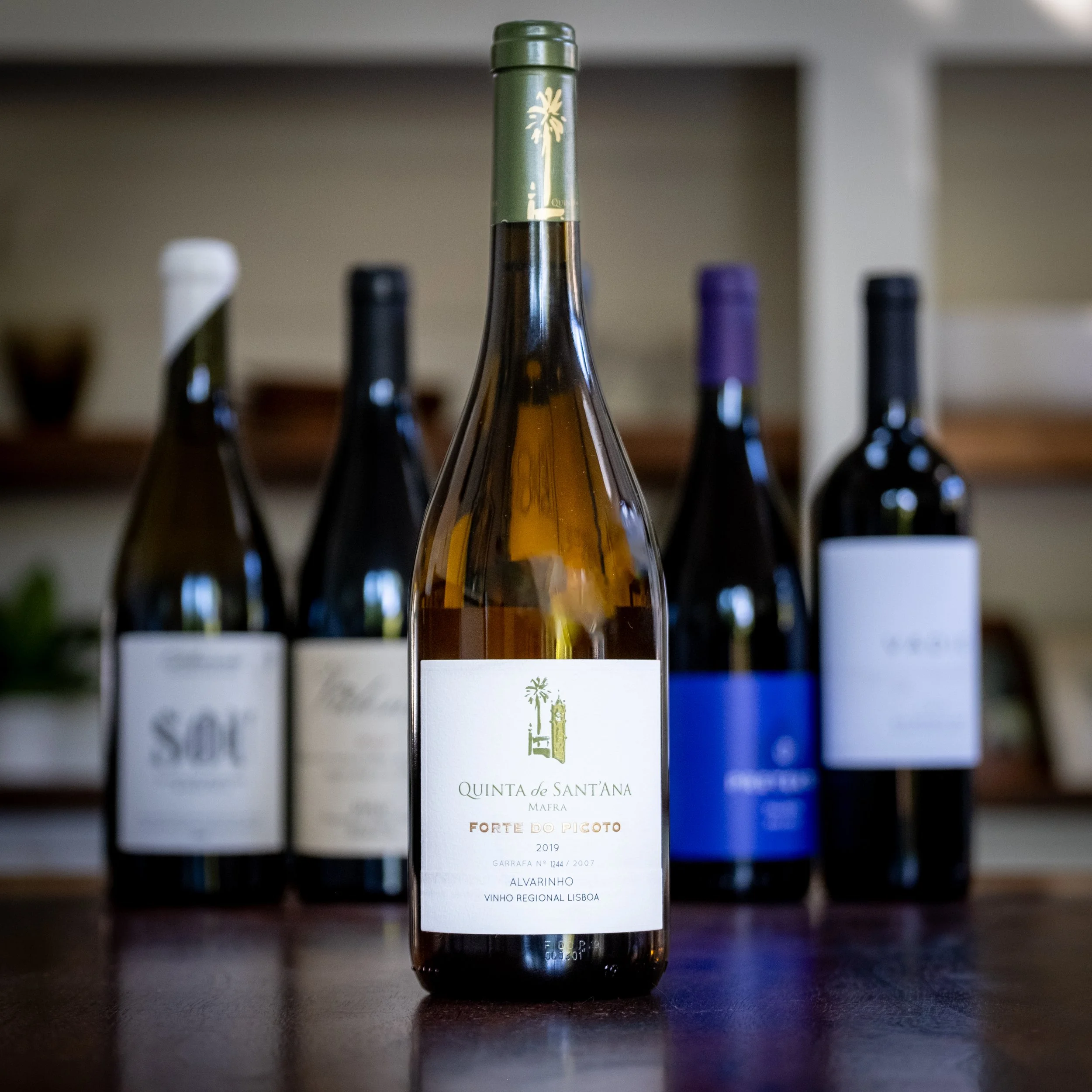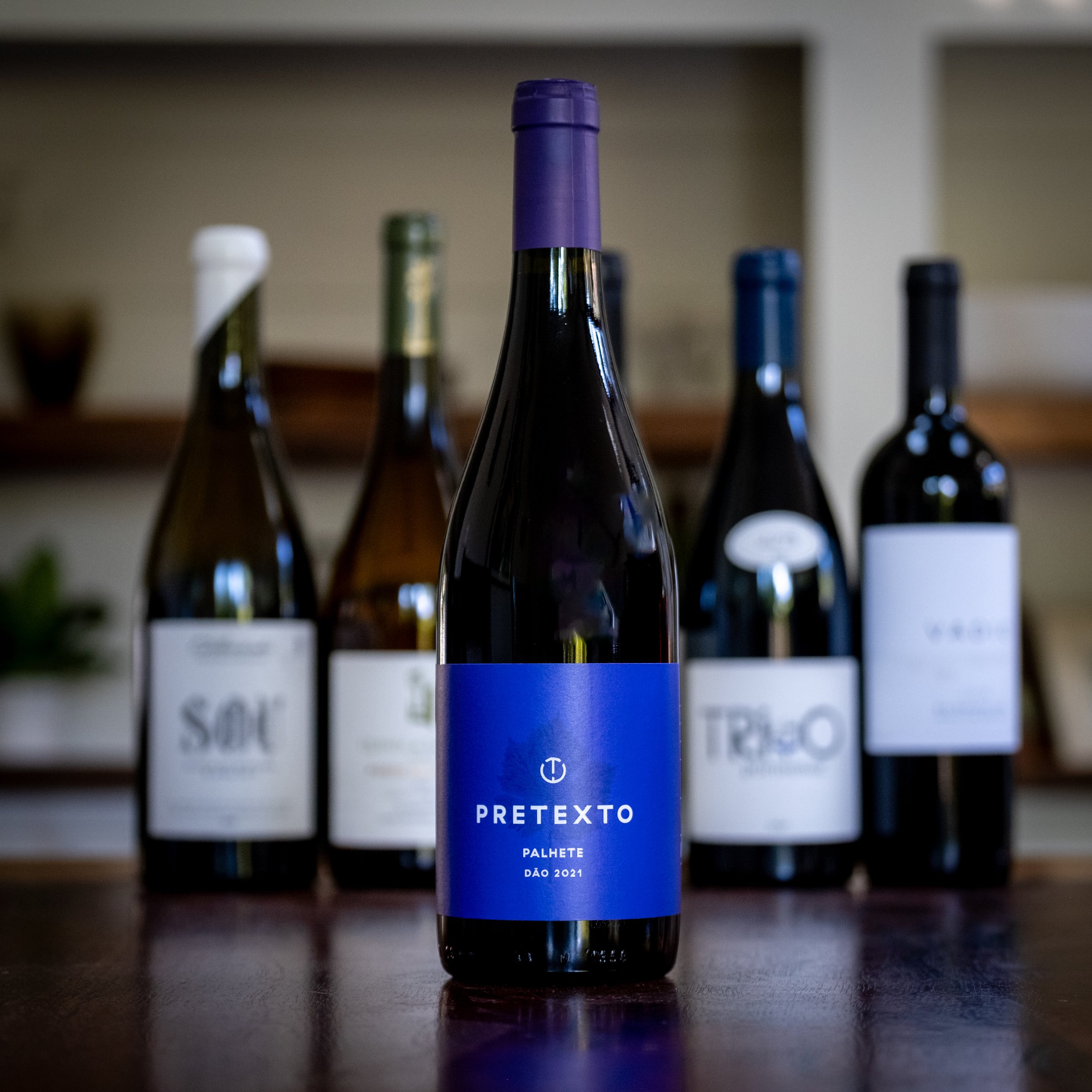Fall 2023 Wine Club
The six club wines are detailed below. Alvarinho is the star of the show with the white wines this Fall with one bottle each from Vinho Verde and Lisboa wine regions. The reds should pop for Fall enjoyment and come from the Douro Valley, Bairrada, Vinho Verde, and Dão wine regions.
2021 Sou Alvarinho
There are few grape varieties in the World right now garnering more attention than Alvarinho (known as Albariño in Spain). There is not finer example than this bottle, Sou Alvarinho. The epicenter for growing Alvarinho is the Portuguese-Spanish border along the Minho River. Portugal’s Vinho Verde wine region is best known for this grape variety, and specifically the sub region of Monção e Melgaço. Situated at the very northern tip of the country (wine map) the village of Monção is about a 90 minute drive north of Porto. The terroir is picture perfect for Alvarinho, which thrives in granite soils. As a medium-to-long cycle variety, the warm summer days and cool evenings of Northern Portugal allow for Alvarinho to fully ripen in all its glory.
Sou is a joint venture between two dear friends Joana Santiago and Nuno Mira do Ó. Joana Santiago’s family has been making wine in Vinho Verde at their farm, Quinta de Santiago, since 1899. She grew up steeped in the history and evolution of the Alvarinho grape and joined forces with Nuno, one of Portugal’s premier artists at translating the pure expressions of grape varietals and their growing conditions in the resulting wines. Sou, translated to English means “I am” and this wine is what this great pair of winemakers feels Alvarinho, is.
2021 Sou is 100% Alvarinho from one vineyard farmed organically at Quinta de Santiago. 2021 was a cool year with a long growing season and thus we get the signature characteristics of the variety in this wine: racing acidity balanced with an incredible, lifted fruit profile. Making this wine is a complicated process done purely by hand. After manual harvest, the grapes are soft pressed and naturally decanted. Half the juice is then fermented in 400-liter barrels of which half completes a process known as malolactic fermentation (you’ll experience this as a creamy, almost velvety texture in the wine). The other half slow ferments in vat after which the wine is aged 9 months on fine lees (lees are dead yeast cells left over from the fermentation process). This is serious Alvarinho!
3,500 bottles were produced, and this wine is allocated to a select few places in the United States. I’m thrilled by this wine as one of the finest examples of the quality happening in Portuguese artisan wine. Enjoy!
A quick note about opening wines with wax-sealed tops, like Sou. You can punch the corkscrew straight through the wax into the cork and remove as you normally would in wines without wax sealing. The Sou corks I’ve opened are in there tight, great for protecting the wines, but you might have to work a bit harder to get the cork out. Fear not, you shall be richly rewarded for your efforts. Cheers!
2019 Quinta de Sant’Ana Forte Do Picoto Alvarinho
Alvarinho is the theme of the white wines for this shipment. See above… it’s one of the finest varietals in the World, capable of enjoyment while young but also of being aged for decades when handled properly in the cellar. When I look for great wines, I first look at the location of the vineyards and the characteristics of that place. Bedrock, soil, vineyard exposition, and the surrounding characteristics like the presence of mountain ranges, rivers, etc. Then comes the farming choices… organic, biodynamic, integrated with other agricultural products, sustainability. Then, of course, the viewpoints and practices of the winemaker. All of these elements (and more) go into what we should expect in the experience of the wine. Quinta de Sant’Ana on the Lisbon coast checks all the boxes.
Nestled in rolling vineyards between the Atlantic Ocean and Lisbon, the Quinta (Portuguese word for “farm”) is a breathtaking property. James and Ana Frost, along with their seven sons and additional family members, infuse the Quinta with a genuine spirit and harness the property’s rich history of wine production and hospitality. A popular destination for weddings, group retreats, families, and couples looking for a getaway, the Quinta is an oasis of enjoyment less than an hour outside of Lisbon.
Quinta de Sant’Ana produces a wide range of wines reflective of the Lisboa wine region’s deep history from their organically farmed vineyards. James always says the wines are made in the vineyards, not the winery, and the care he and his family and winemaking team have for the land is clear. Situated less than 10 miles from the Atlantic coast and 300 to 450 feet above sea level, the Quinta is blessed with a unique microclimate of cool nights, cloudy, misty mornings, and sunny afternoons. The Atlantic climate sweeps across the electric patchwork of calcareous clay slopes with vines weaving into different aspects of valleys, peaks, and ridges. The resulting wines are fresh and vibrant. Perfect for Alvarinho!
James and his winemaking team, headed by the esteemed Antonio Maçanita, began converting the vineyards to full organic farming in 2015 and achieved organic certification in 2018. Minimal intervention winemaking guides all decisions in the winery allowing the natural characteristics of the terroir to shine through in the wines. 2019 Forte do Picoto is 100% Alvarinho and with a few years of bottle age, it’s in it’s glory! Smooth pressing of whole bunches by pneumatic press extracts the best must, which is allowed to settle for one day to decant. 80% of the wine ferments in stainless steel tank with the other 20% in used oak barrels with frequent lees stirring. This is a practice that gives greater volume to the wine. The wine ages for 10 months before bottling.
The wine has distinct aromas of peach and orange blossom, with a slight herbal twist. Stone fruits continue on the palate, with delicate vanilla touches from barrel-aging along with fresh hazelnut and brioche. Lively freshness and superb acidity with a lingering finish. Due to the complexity of this wine and searing acidity, it can stand up very well against richer, more intense flavors of both fish and meat dishes.
2019 Pormenor Trilho Tinto
The distinctive Pormenor logo and braille features look familiar to many members, as we enjoy wines from Pormenor consistently. They remain core examples of the type of artisan practices bringing Portuguese wines to the forefront of great restaurant wine lists and prominent wine shops in the States (and beyond). Trilho Tinto is Pormenor’s top red wine, and there is very little of it produced given the ancient age of the vines. Pormenor means “details” in Portuguese, and Pedro Coelho, owner and winemaker is hyper focused on the details that count when making incredible wines. I’ve been working with Pedro as long as I’ve been importing wine. One of the details Pedro insists on is old vines and the vineyard producing the grapes for Trilho is over 80 years old. This type of aged, fully mature old vine fruit is rare in the eastern part of Douro Valley where most vineyards are relatively new. This treats us to special qualities in these grape varietals not present in less mature vines.
Elevation plays an important part in viticulture globally, but in the Douro Valley where daytime summer temperatures are regularly above 85-degrees, high elevation vines slow the maturation typically accelerated by warm weather. Old vines at high elevation are a prime combination for creating special wines like Trilho Tinto. The grapes in the blend are Tinta Roriz (known as Tempranillo in neighboring Spain), Tinta Barroca, and Touriga Franca. Harvests are by hand and Pedro’s focus is to stay out of Mother Nature’s way and minimize human intervention in the winemaking process. Grapes for Trilho are meticulously selected, a practice that drives the small production quantity. Fermentation is in large, old wooden vats called “balseiro” and done in three equal methods. One-third is fermented with 100% whole bunch. Another third with 50% whole bunch, and the final third just the fruit. The fermentation and maceration is eight weeks long with minimal pump overs to soften extraction. The wine is then aged in used French oak barrels for two years before bottling.
Pormenor Trilho Tinto is justified as a “benchmark”, reference wine for Douro Valley reds. The wine is discreet and doesn’t overpower. It is vibrant and fresh, and I would describe it as elegant but not overly lush or “big”. It has aging potential but can be enjoyed now. The wine pairs wonderfully with foods that would be typical for red wine though I almost always enjoy at least a little bit without food.
2018 Vadio Tinto
Vadio is a family-owned and run project in the Bairrada region founded in 2005 by husband and wife team, Luís Patrão and Eduarda Dias. Luís is a renowned winemaker well-known for the quality of his farming and viticultural practices. All 7.5 hectares are farmed certified organic… and Luís goes so far as to create his own, homemade composts. Eduarda handles the business development and administrative elements and together they are pursuing their passion of working with the Bairrada wine region’s most important native varietals to produce authentic wines.
Vadio is in the Bairrada wine region (wine map here) between Lisbon and Porto along the Atlantic Ocean. The winery is based in the small village of Poutena. The Atlantic Ocean’s climate influences combined with clay and limestone soils and native varietals contribute to the uniqueness of Vadio’s wines. They are known for their red wines featuring the Baga grape and the production of some of Portugal’s best sparkling wines. When I first tasted their wines and got to know the depth and care that Luís takes in the vineyards and cellar, I knew I had to bring it to the United States to share with you.
Vadio Tinto is their “flagship” red wine and features the King Grape of the Bairrada… “Baga”. Among winemakers, sommeliers, and wine lovers in Portugal, Baga is something of a mythical grape varietal. It is notoriously challenging to work with, much like the Pinot Noir varietal in that way, but in the hands of a winemaker like Luís, the wines can be spectacular. The 2018 has some bottle age, but well-made Baga can age gracefully for decades. At Vadio, harvest is by hand and the 2018 Tinto has Baga grapes from all four vineyards. Each plot is vinified separately with the same process. 50% of the grapes are pressed with whole bunch (stems and all) included. The wine matures in used oak vats and barrels for 24 months before bottling with 12 more months in bottle before the wine is released. The 2017 has an expressive bouquet in the glass suggesting wild berries and and balsamic notes. Elegance is a word that comes to mind when tasting this wine. Tannins are present but silky, and the wine has vibrant acidity. I like this wine with a variety of foods, much like the flexibility of Nebbiolo from Northern Italy.
2019 Mira do Ó Vidente
Gazing back at the Portuguese wine region map, you’ll see that just east of Bairrada is the Dão region. You’ve enjoyed the Textura wines from the Dão region regularly. The Dão is a hotbed for emerging artisan wines given its elevation on the granite slopes of the Serra da Estrela mountain range and associated, relatively cool resulting temperatures. Nuno Mira do Ó has been attracted to vineyards in the northern part of the Dão for more than a decade. Nuno’s name was mentioned above as the co-owner of the Sou project in Vinho Verde, and Nuno’s experience with both viticulture and oenology is second to few in all of Portugal. He is a leading source of information globally on the wine regions, varietals, and resulting wines of Portugal.
The Dão region has different yet equally attractive geographic and climatic conditions from neighboring Bairrada. Being further inland, the influence of the Atlantic Ocean is still present but muted. The dominant feature of the Dão is the presence of Portugal’s tallest inland mountain range, the Serra da Estrela. With peaks over 6,500 feet, it impacts growing conditions and keeps the warmer inland temperatures at bay enough to create a longer growing (ripening) season for the grapes. At 1,500 feet of elevation, Nuno’s vineyard in Dão is elevated from coastal Bairrada, which also helps mitigate the summer heat. Granite is the dominant soil type in this area and it imparts different elements on the vines than the softer clay soils further west toward the coast.
2019 was a warm winter but a cool end of spring and summer. This allowed slow ripening and excellent levels of natural acidity and aromatic elegance. These grapes were hand-picked in mid-September and the result is a unique terroir-driven wine full of character, elegance and texture. Mira do Ó Vidente is made from 30-year old vines and is a blend of varietals native to the the Dão: Jaen, Alfrocheiro, Tinta Pinheira, and Touriga Nacional. Harvest is by hand followed by a slow fermentation in stainless steel tank. The wine is aged 20 months, part in tank and part in used French oak barrel before bottling in July of 2021. It has a ruby color with aromas of cinnamon, cherry, a cocoa. The mouth is elegant with silky tannins that linger through the long after taste. I love this wine with food and pair it with a wide variety of meat-based dishes.
2021 Textura Palhete
The name Textura is familiar to long-time Wine Club Members as a pillar of fine artisan Portuguese wine. This lovely family’s wines from the Dão region are on fire globally, and I’m delighted to keep exploring their range of wines with you. While the grower producer might be becoming familiar to you, this particular style of wine, “Palhete” likely isn’t. It’s not a common category in the United States as it doesn’t fit neatly into white, rosé, red classification. Palhete wines are far more common in Portugal as this is a blend of red and white grapes co-fermented. This became a common practice in Portugal given the prevalence of “fields blends”, or vineyards being planted with multiple grape varieties together.
As mentioned above with Mira do Ó Vidente, the Dão has one of Portugal’s most attractive combinations of climate and geographic features offering optimal grape growing conditions. Marcelo Araujo and his family are the owners and driving force behind Textura. Mariana Salvador is the winemaker, and she is assisted in the cellar decisions by consultant, Luis Seabra. Textura is the southern subregion of Serra da Estrela, where the granite slopes of the mountain provide less topsoil relative to the northern regions that have more clay on top of the granite. All viticulture at Textura is organic, and this type of thoughtful farming shines through in the glass with a sense of place and purity of the fruit and soil characteristics.
2021 Textura Palhete is 70% red grapes, specifically Jaen (known as Mencia in Spain) and Alfrocheiro. The remaining 30% white grapes are Encruzado and Bical. All four varietals are native to the Dão region. The vines are between 25 and 60 years of age at about 500 meters altitude. The grapes fermented together in an old ânfora (large clay pot) for 15 days then aged in 225-liter used oak barrels before bottling. The dominance of the red varietals in the blend drive the color, though it is not as dark as a typical red wine from Dão given the 30% white grapes in the blend. Aromas includes spices, discreet fruit and green notes associated with whole bunch fermentation. In the mouth the acidity is present, making this a great wine to pair with lighter dishes. I like to serve Palhete wines chilled - not as cold as a white, but cooler than a cellar-temperature red.






